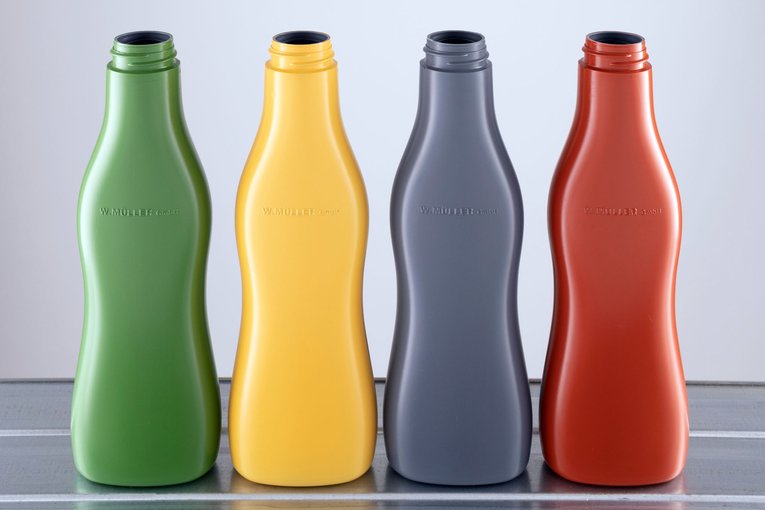The colorful diversity of PCR processing
Plastics and sustainability | 26. July 2022

Use PCR materials without optical losses or impairment of the filling material! Blow molding specialist W. MÜLLER GmbH from Troisdorf makes PCR processing suitable and attractive for everyday use!
The blow molding specialists at W. MÜLLER GmbH in Troisdorf, Germany, were able to prove in their in-house technical lab that the processing of PCR does not result in any loss of article quality and properties.
The technical center has two blow molding machines and thus offers interested parties the opportunity to test the processing of PCR without downtime in their own production and to design it for their own product. For this purpose, the new material used is also tested in order to achieve reliable comparisons.
Depending on the quality of the PCR material, loss of mechanical properties, impurities or processing problems can be expected. For this purpose, the properties of the original virgin material and the available PCR material must be compared.
Varinia Lück, head of the W. MÜLLER Technical Center, comments:
"PCR materials are new territory for many processors. We already gained experience with such materials from a wide range of manufacturers in 2005. We test processability, performance, support migration tests and help in case of loss of mechanical properties, impurities or processing problems"
To compensate for deviations in the mechanical properties of the articles produced, W. MÜLLER relies on ReCo3 technology. This is a three-layer process in which a layer of PCR is embedded by two thin layers of virgin material. In this way, for example, the compression pressure can be brought to the desired value.
If the appearance is to be improved, a thin outer layer is sufficient to cover black dots. Many PCR materials on the market are gray, blue or green. Only very few are light or natural colored. With ReCo3, it is possible to use dark PCR materials and still produce packaging in the desired and sometimes required colors, exactly as with virgin materials. Overall, the amount of masterbatch required is also lower, resulting in cost savings.
If the availability of PCR materials fluctuates, this is no problem for ReCo3. The layer thicknesses can be adjusted with just a few settings.
In order to be able to provide support for all questions concerning PCR processing, W. MÜLLER arranged its own tests in its technical center, and Varinia Lück reports on the results:
"A special focus in PCR processing is the safety of the filling material. First we compared a 1L bottle in Mono and ReCo3 to find out what effect a virgin inner layer has on migration. Results show that migration of substances into the filling material is reduced. This increases the safety of using PCR materials in cosmetic bottles such as lotions or creams. The migration and the evaluation of the tests depend on many factors. Two important ones are the contact area of the bottle with the filling material and the application. Therefore, we additionally performed migration tests for leave-on applications in our 70 ml cosmetic bottle in ReCo3. The 70 ml cosmetic bottle has a higher contact area than a 1L bottle and more product is absorbed by our body in Leave-On applications than in Rinse-Off applications. This made this test a sort of "worst case" scenario. The two bottles tested are both compliant for use as packaging filled with Leave-On products. " - Truly performing.